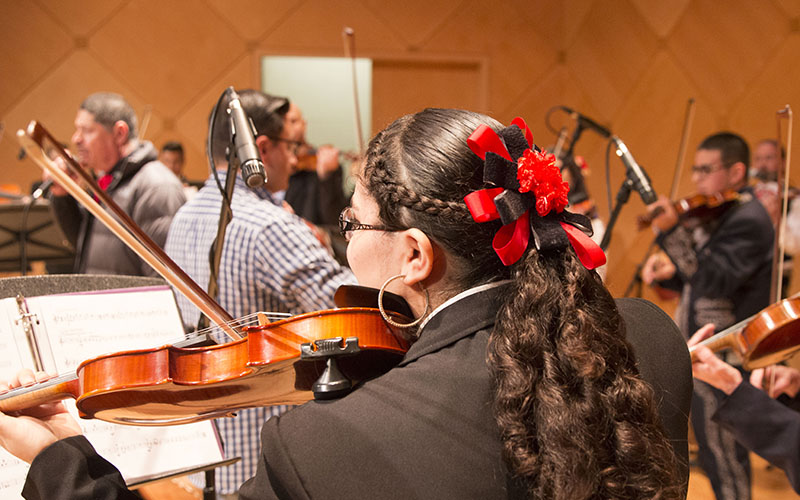
A young violinist rehearses before the concert with a “moño,” or bow, in her hair. (Photo by Claire M. Roney/Cronkite News)
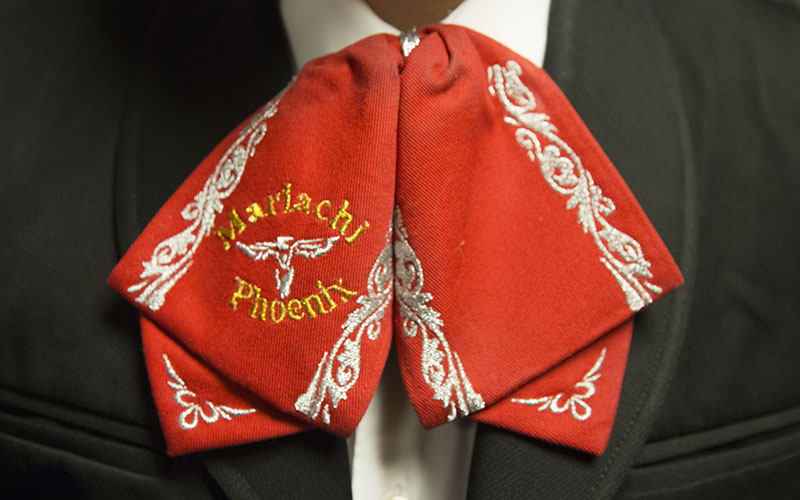
Michael Smith’s “moño,” or bow tie, is part of the traditional mariachi costume. (Photo by Claire M. Roney/Cronkite News)
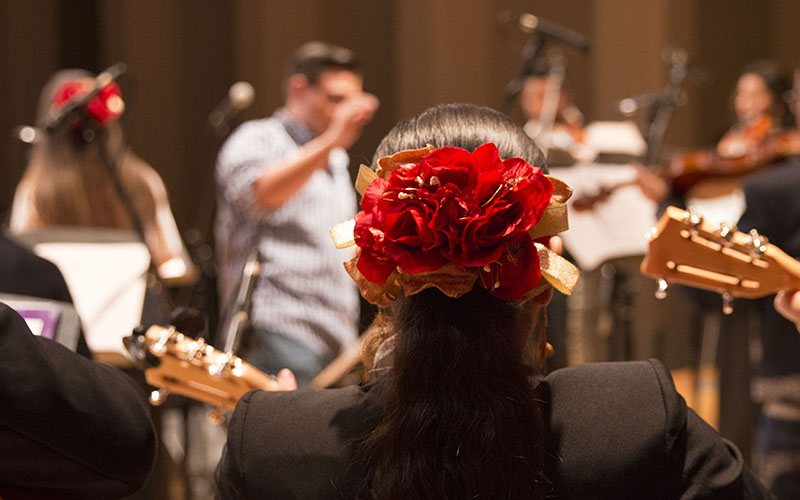
During a pre-concert rehearsal of the ASU Mariachi Ensemble, Claudia Sanson’s hair bows contrasts with her black jacket. (Photo by Claire M. Roney/Cronkite News)
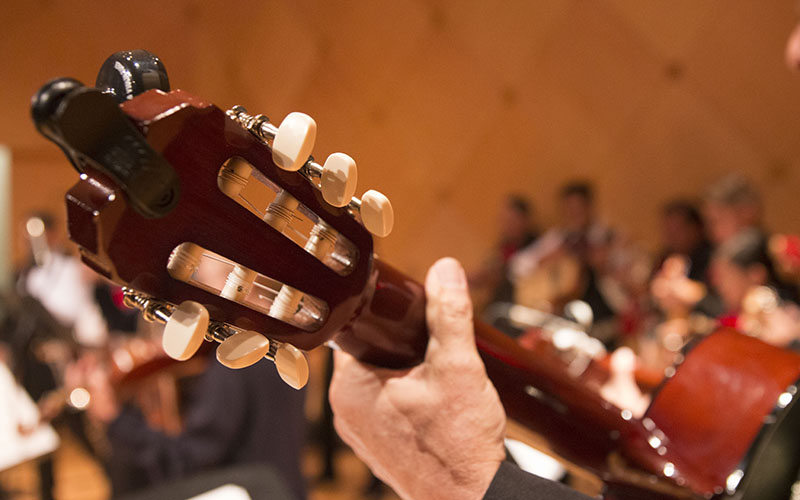
A guitar is one of the instruments that contributes to the unique sound of mariachi. (Photo by Claire M. Roney/Cronkite News)
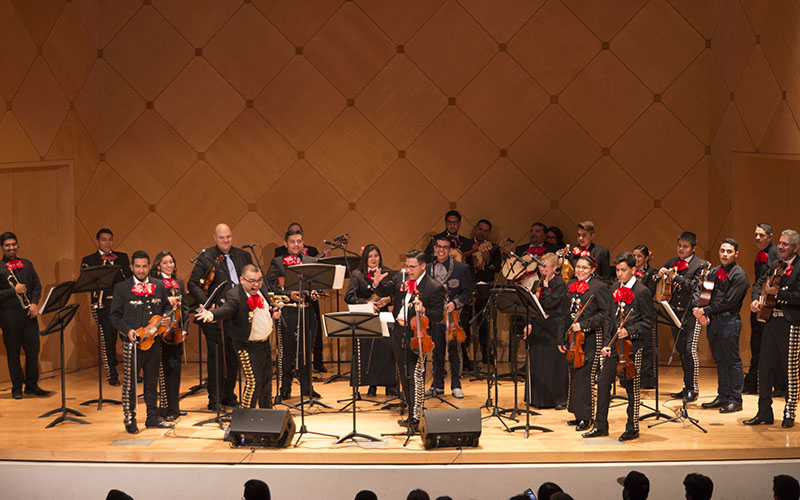
Co-directors of the ASU Mariachi Ensemble Michael Smith and Carlos Castañeda led the audience in a chorus of gritos on Nov. 28. (Photo by Claire M. Roney/Cronkite News)
TEMPE – On a Monday evening in September, Michael Smith hummed quietly and scrawled the names of mariachi songs on a whiteboard.
Smith, 25, is a co-director of the Mariachi Ensemble at Arizona State University.
The origins of the Mexican folk music genre date back to the 16th century, and it’s a fusion of indigenous, African and Spanish musical traditions. Mariachi has become part of the American cultural fabric, and represents the social and political values of the Mexican people. On Election Day, for example, a mariachi band played outside Trump Tower in New York in what some viewed as a protest of President-elect Donald Trump’s campaign promises to build a border wall at Mexico’s expense and deport all undocumented immigrants.
Michael Smith’s interest in Mariachi music was kindled when his Latina mother took him as a 5-year-old to a mariachi concert in California. He remembers seeing a little boy entering the concert stage, singing and dancing and playing a violin.
Smith said he felt the music’s liveliness and its passion so much that he turned to his mother and told her, “I want to do that.”
“I got a violin, I showed up to class and I just started learning the music,” Smith said.
When he was 18, Smith played with Mariachi Los Camperos de Nati Cano in the Encuentro Internacional del Mariachi y la Charreria; an international mariachi music festival held in Guadalajara, Mexico.
“I blacked out the memory of being on stage. I can’t remember a thing, for the life of me,” Smith laughed.
It was one of the happiest, most nerve-wracking and exhilarating moments of his life, he said.
Now a classical music major seeking his master’s degree at ASU, Smith said his goal is to promote and preserve mariachi music. Boyish and energetic, Smith uses his classical music skills to influence modernizations of mariachi music.
“Mariachi has evolved over the years: what started as folk music, where a group of people got together and made songs and music, has turned into a group that is very similar to a jazz ensemble in the sense that we’re a cover band,” Smith explained.
The ensemble first began in 1985 under Richard Haefer. Haefer retired in 2011, and the mariachi class was dropped from ASU’s curriculum. Mariachi fans, upset by the removal of the class, pushed back, and was able to resurrect the course to the curriculum in 2012.
Today, the ASU ensemble meets once a week, and has 25 members consisting of ASU students and community musicians interested in mariachi music.
Smith’s goal is to preserve the rich history of the genre while modernizing it with classical techniques and cover songs, like “Can’t Take My Eyes Off You,” the Frankie Valli and The Four Seasons hit.
The end of the cultural-musical journey for the band, Smith and co-director Carlos Castaneda: the ensemble’s Nov. 28 mariachi concert at the ASU Tempe campus.
To pull it off at the Nov. 28 concert, to make it real, the musicians would have to feel the music, and play it with skill.
A 500-year history
The legacy of mariachi music dates back to the 16th century.
Indigenous people in what is now Mexico had long developed musical instruments by the time the Spanish conquistador Hernan Cortes arrived in Mexico around 1521, according to History.com. Known for his cruelty and slaughter of native peoples, Cortes also brought musicians on his ship. According to Smithsonian Folkways, the folk music is a fusion of indigenous, Spanish and African music. Instruments like the vihuela, a Spanish guitar, gave mariachi its particular sound.
As mariachi evolved, the elaborate costumes -three-piece suits, boots, ties, belts, buttons and large sombreros evolved from traditional charro (cowboy) costume, to today’s elaborate, custom-designed outfits.
‘The music, I love it’
Aurelio Gúzman, 42, is a landscaper by trade, and a mariachi musician at heart. As he plucked away at the strings of his vihuela during a recent Mariachi Ensemble practice session in an ASU classroom, he said: “The music, I love it.”
Gúzman did not come from a musical family, but he loved mariachi music so much he decided to learn it when he was in his early 30s, he said. He has played in a mariachi ensemble called Luz Del Soro for about six years.
His instrument of choice is the vihuela, but he first learned to play mariachi music with a guitarron: a six-string bass guitar also required in a mariachi ensemble.
The guitarron’s large bulk and weight combined with the heavy mariachi costumes makes for a sweaty performance, he said, but the joy of playing mariachi made up for the discomfort.
“You know, if you love what you do, it’s not work,” Gúzman laughed, preparing himself for the first song of the class.
Marques Maldonado, 25, an ASU student, warmed up his voice in the corner of the classroom.
“Mariachi music speaks from the heart and soul, whether it be romantic or sad. It is a genre of music that originated in Mexico that will forever be played,” he said.
His trumpet rested between his legs as he practiced the lyrics to a love song. He tapped his knees, drummed his fingers and took a deep breath.
Members raised their instruments for the first song. A hush filled the room. Then, violin wands passed over taut strings, fingers plucked and brushed over guitars, trumpets blared and Maldonado belted a song called “Loco.”
Anarbol Martinez, a trumpet player, raised his head high and let out a whooping cry as the song played: a grito.
It was a cry of joy, and it was loud.
‘Dropping something on your big toe’
The grito, which means ‘the shout’ in Spanish, is closely identified with mariachi music and could be a cry of pain, joy, remorse, anguish, relief, love, or all of those things at once.
On Sept. 16, 1810, Catholic priest Miguel Hidalgo y Costilla delivered the “Grito de Dolores” to a crowd of Indians and mestizos, pleading them to take up arms against their Spanish rulers in the Mexican War of Independence.
According to the Library of Congress, the priest shouted:”My Children, a new dispensation comes to us today…Will you free yourselves? Will you recover the lands stolen 300 years ago from your forefathers by the hated Spaniards? We must act at once.”
Each year on Sept. 16, Mexico celebrates its Independence Day around the world with a re-enactment of the Grito de Dolores.
The grito traditionally ends with three shouts of “Viva Mexico” in honor of Mexico’s Independence Day and in remembrance of Hidalgo.
The Independence Day grito has a more musical mariachi version.
In mariachi, each grito is unique to the singer’s passion.
“We get a lot of questions about the gritos [during performances], so we do a demonstration with the audience and my go-to has always been to say, ‘dropping something on your big toe’ and vocalizing the pain,” Smith said.
‘And they loved it’
For months, the ASU Mariachi Ensemble had practiced for the Nov. 28 concert, and the day had finally come. It was chilly evening, and musicians arrived at the Katzin Music Hall on the ASU Tempe campus around 6 p.m. wearing mariachi costumes beneath their winter coats.
As musicians filed onto the stage to practice songs, co-directors Castañeda and Smith were last-minute coaches, helping musicians tune instruments and adjusting their positions on the stage.
The energy was high, the musicians were ready to go.
Once the practice ended, about 225 people filed into the music hall.
Backstage, musicians chatted in Spanish, cracked jokes and adjusted their moños: fanciful oversized bows used as neckties for the male musicians or hair ornaments for the women.
At 7:30 p.m. the ensemble entered the stage area smiling almost as if coming home to their audience. Friends and relatives cheered for the musicians, releasing an occasional grito.
Smith and Castañeda provided an English and Spanish introduction briefly before joining the ensemble ranks to play a lively instrumental that set a the tone for the evening’s lively mood.
La Cigarra, a song about a cicada singing as it faces death, followed with a robust end by singer Claudia Sanson booming “la ci-gaaa-rrrr-aaah.” The crowd jumped to its feet, cheering the singer’s conveyance of sorrow and triumph.
Maldonado and Smith took a step away from traditional mariachi with a performance of “Can’t Take My Eyes Off You” by Frankie Valli and the Four Seasons. The crowd seemed surprised and amused by the sudden shift — a pop hit from the 1960s turned into a mariachi song.
The evening was nonstop emotion and commotion: the audience sang, clapped, cheered and bellowed gritos with the ensemble.
The musicians seemed as though they never wanted to stop playing, but when the concert ended the musicians bowed in gratitude.
Gúzman, the vihuela player, marveled at the audience’s intensity and enthusiasm as he exited the stage. He had played in the ensemble for several years, but he’d never seen anything like this audience.
“I think it was really, really great,” he said. ‘”You know, all the concerts are great, but this audience was so happy. They were clapping and singing and cheering. And they loved it. I loved it.”